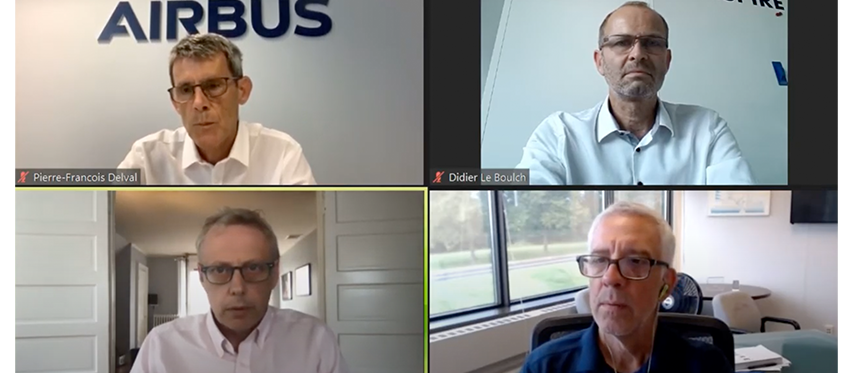
Panelists at APSCC discuss the industry impact of flexible satellites
Flexible satellites, also referred to as flexible payload satellites, are a hot topic – though not necessarily a new topic in the industry. As early as 2015, operators were clamoring for manufacturers to build flexible payloads that could be reconfigured on orbit. Such reconfigurable coverage would help to drive down costs and enable the satellite industry to become more agile and responsive to market needs.
Now, five years later, where does the industry stand today in terms of meeting those goals? That’s the question Pierre Francois Delval of Airbus DAS, Dave Rehbehn of Hughes, Didier Le Boulc’h of Thales Alenia Space, and Graeme Shaw of ArgoSat pondered recently during a panel at the first all-digital Asia-Pacific Satellite Communications Council (APSCC) 2020 conference.
The Evolution from HTS to Flexible
The session began with Mr. Shaw providing an overview of how High Throughput Satellites (HTS) have evolved to support better economies of scale. He explained that each user on the ground costs a share of resources on a satellite, in terms of its power and bandwidth. Building a bigger HTS that has smaller and smaller spot beams – and more of them – drives down the marginal cost of each user. Having smaller beams means there can be more for a given coverage area; that increases spectrum reuse and results in a situation where an HTS with a greater number of smaller beams can address the connectivity needs of more users, more affordably.
As beam size shrinks, the amount of satellite power consumed to address a single user also decreases. When the number of spot beams for a given coverage area increases, maximum throughput also increases and more users can be served. Therefore, the easiest way to achieve a lower cost/Mbps is to build bigger satellites, which has led to the emergence of Very High Throughput Satellites, or VHTS.
Mr. Rehbehn and other panelists stressed that not every market can support a massive satellite and not all operators have access to large markets. This is where flexible satellites can improve the economics because bandwidth can be allocated to more accurately meet demand. Electronically formed beams can also be made small and with lower bandwidth. By not illuminating all beams at all times, they are decoupled from the coverage area, enabling better capital management. With each new generation of HTS, the capital expense per Mbps goes down exponentially; conventional satellites simply cannot compete at these prices. But flexible satellites can, according to the panelists.
Flexible satellites also offer the ability to change character over time, for example to support data or to become a Direct to Home (DTH) broadcast service (or vice versa) explained Mr. Le Boulc’h. They offer a good transition option for operators that may need to adjust their business plans based on market demands.
Flexibility Takes Flight
Mr. Rehbehn noted: “Flexibility is most critical when it comes to applications where demand is uncertain or transient, where mobility is a key factor or in new markets. Hughes is adopting our JUPITER™ ground system to support flexibility in the near term, particularly to accommodate aero mobility. With the correct kind of flexibility in the satellite, the ground system and with resource management, you can allocate bandwidth and beams to follow the waves of flight routes where you could have a satellite beam for a given aircraft. The challenge there is distributing the new frequency plan in a timely fashion and synchronizing it with the satellite, and the tuning and acquisition times of the carriers. We’re not at the point where we can achieve it minute-by-minute, but we’re planning to support hour-by-hour flexibility. As technology changes, that will improve.”
What Might Full Flexibility Look Like?
The concept of flexibility might also involve operators adapting their services and satellite placement once markets mature. Mr. Delval noted that if an operator tested a market by using a flexible satellite and saw that demand pointed to the need for greater capacity, they might choose to bring more “brute force” in to support that area’s demand for services and coverage. They could then move the flexible satellite to another location to test another market.
Typically, for more conventional usage, configurations may change a few times over the life of a satellite. But in a fully flexible scenario, it might be possible for software to define configuration changes down to the hour or minute, creating a true and dynamic flexibility to track with customer demand. Such capabilities would require major deployments of complex ground systems for the level of regenerative processing required on-board. To maximize this type of flexibility would also require operator investment and support; it wouldn’t make sense to build such a high degree of flexibility unless operators could benefit from it.
Another topic of discussion was the possibility that manufacturers would build standard satellites, using the same components for every customer. The customer would then configure the satellite in orbit to meet specific needs. This becomes more of a mass manufacturing exercise once the satellite’s design is complete.
“The economics of these flexible satellites are partly driven by the fact that they are generic and thus there is no non-recurring engineering (or ‘NRE’) per satellite,” Mr. Rehbehn explained. “The economics improve enormously if you are able to make a phone call tomorrow and say, ‘I’d like a satellite over this location,’ and then someone has a satellite or beams over that location within a short period of time.”
Regardless of specific outcomes – be it near real-time agility or the chance to test new markets cost-effectively – increased satellite flexibility will improve economics, lower barriers, and influence the entire industry in significant ways.
Watch the full APSCC session.